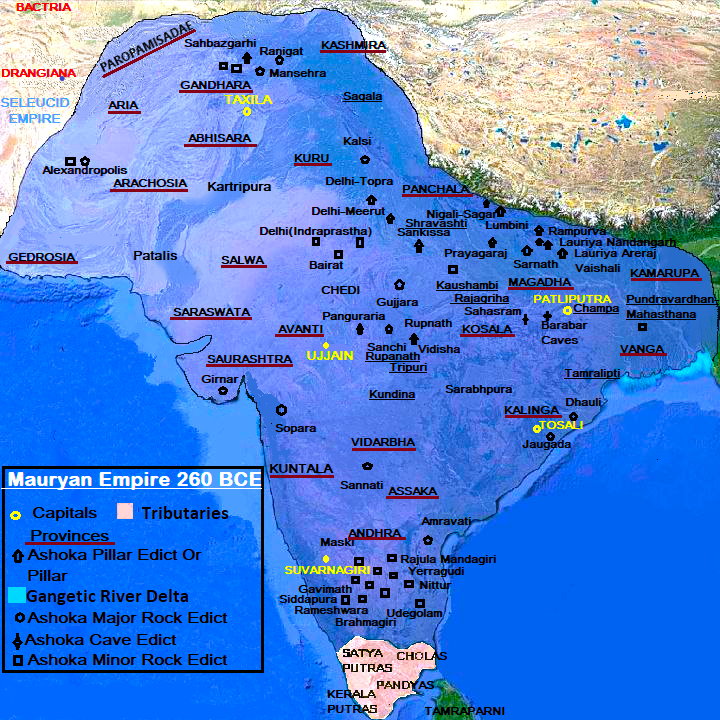Introduction: A Kingdom That Changed India Forever

5 Key Moments Rise and Fall of the Maurya Empire
Imagine a time when India was divided into small kingdoms, constantly at war. Then, from the heart of Magadha, a young warrior named Chandragupta Maurya rose, guided by a brilliant strategist Chanakya, and built an empire that stretched across the Indian subcontinent. This was the Maurya Empire, the first dynasty to unify most of India under one rule. But the real twist in this story came with Ashoka the Great, a ruthless conqueror who transformed into a peace-loving emperor.
How did this empire rise? How did a warrior king give way to a Buddhist ruler? Let’s explore the incredible journey of the Maurya dynasty!
1. Chandragupta Maurya: The Boy Who Dreamed of an Empire
In 321 BCE, Chandragupta Maurya, a boy from a humble background, had a chance encounter with Chanakya, a genius strategist and political thinker. Legend says Chanakya saw something special in him—a fire to rule. Under Chanakya’s guidance, Chandragupta trained in warfare and politics.
At that time, India was under the rule of the Nanda Dynasty, known for its corruption and unpopular policies. With an army raised from scratch, Chandragupta defeated the Nandas and became the king of Magadha, marking the beginning of the Maurya Empire.
But he didn’t stop there. The biggest challenge was the mighty Seleucid Empire, led by Alexander the Great’s general Seleucus I Nicator. In an astonishing turn of events, Chandragupta not only defeated Seleucus but also gained large territories, including present-day Afghanistan and Pakistan. As a diplomatic move, Seleucus even gave his daughter’s hand in marriage to Chandragupta!
2. The Mauryan Administration: A Well-Oiled Machine
One of the biggest reasons the Maurya Empire flourished was its incredible administration. With Chanakya’s guidance, Chandragupta established a highly organized governance system, which was later recorded in the famous book Arthashastra.
- A Centralized Government – The emperor had absolute power but relied on ministers.
- Provinces & Governors – The empire was divided into provinces with local rulers.
- Spies & Intelligence – The Mauryas had one of the earliest known spy networks!
- Strong Military – A massive standing army ensured control over vast lands.
Chandragupta’s reign lasted for about 24 years, after which he mysteriously renounced his throne, converted to Jainism, and fasted to death at Shravanabelagola in Karnataka.
3. Bindusara: The Forgotten Mauryan Ruler
After Chandragupta, his son Bindusara took the throne. Though not as famous, Bindusara expanded the empire further south and maintained peace. Interestingly, Greek sources called him Amitrochates, meaning “Slayer of Foes,” which proves he was a powerful ruler.
But history remembers Bindusara not for his wars, but for his son—the future emperor who would change the fate of India.
4. Ashoka the Great: From a Ruthless Conqueror to a Messenger of Peace
When Ashoka became emperor in 268 BCE, he was a fierce warrior, determined to expand the empire. His biggest and bloodiest war was against Kalinga (present-day Odisha). After a massive battle, over 100,000 people lay dead, and the sight of the devastation changed Ashoka forever.
Legend says he walked through the battlefield, seeing bodies of men, women, and children, realizing the cost of war. From that moment, he decided to give up violence and embrace Buddhism.
- He started promoting Dharma (righteousness) instead of war.
- He built Buddhist monasteries and stupas, including the famous Sanchi Stupa.
- His Ashokan Edicts, carved on rocks and pillars across India, spread messages of peace, morality, and compassion.
Ashoka transformed from a conqueror to a spiritual leader, making him one of the greatest rulers in world history.
5. The Decline of the Maurya Empire: What Went Wrong?
After Ashoka’s death in 232 BCE, his successors were weak and couldn’t hold the vast empire together. Regional rulers started breaking away, and by 185 BCE, the last Mauryan ruler, Brihadratha, was assassinated by his own general, Pushyamitra Shunga, who started the Shunga Dynasty.
The Maurya Empire had ended, but its legacy lived on. Ashoka’s influence spread across Asia, shaping Buddhism in Sri Lanka, China, and Japan. Even today, India’s national emblem—the Lion Capital of Ashoka—comes from this period!
Conclusion: A Dynasty That Still Inspires
The Maurya Empire was more than just a kingdom; it was a turning point in Indian history. From Chandragupta’s fierce conquests to Ashoka’s message of peace, it left a lasting mark on the world.
Even today, we see its influence in India’s governance, Buddhism, and national symbols. The Mauryas remind us that power can be used for both conquest and compassion—and that history always has lessons to teach us.
